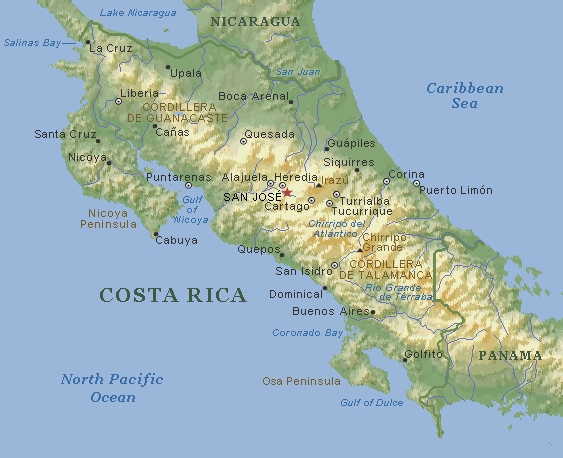Lesson 1 - Where is Costa Rica and what is the physical environment like?
Learning objectives:
- to be able to locate Costa Rica
- to be able to describe at least 3 different physical environments in Costa Rica
- to be able to explain why these environments attract tourists
Costa Rica is a small country in Central America. There is a coastline on both the east (Caribbean Sea) and the west (Pacific Ocean) side of the country. You can travel from east to west coast in about 3 hours by car or 45 minutes by plane.
To the north, Costa Rica is bordered by Nicaragua. To the south, it is bordered by Panama. It is a tropical country, lying in the Northern Hemisphere between the equator and the Tropic of Cancer.



A series of volcanic mountain chains run from the Nicaraguan border in the north-west to the Panamanian border in the south-east, splitting the country in two. In the centre of these ranges is a high-altitude plain. There are coastal lowlands on either side.
The Caribbean coast is 131 miles long and has many mangroves, swamps and sandy beaches. The Pacific coast is much more rugged and rocky and is 630 miles long with many gulfs and peninsulas.
Costa Rica's environment is very diverse - this region of the world is considered one of the most biodiverse. The country's biodiversity attracts nature lovers from all over the world. The primary attraction for many visitors is the 850 recorded bird species, which include the quetzal, indigo-capped hummingbirds, macaws and toucans. Costa Rica's tropical forests have over 1400 tree species and provide a variety of habitats for the country's fauna including four types of monkey, sloths, armadillos, jaguars and tapirs. There are also a number of dazzling butterflies. National parks cover almost 12% of the country, and forest reserves and Indian reservations boost the protected land area to 27%.
Beaches
According to the official Costa Rica tourism website - www.visitcostarica.com
"Costa Rica's beaches are surrounded by forests, and have great natural diversity. In many of them there are beautiful coral reefs, where you may dive and explore. In addition, depending on the place visited, you have a series of complementary activities, such as: hikes to mangroves, diving, surfing, sport fishing, hiking on trails or horseback rides. Thanks to the easy access to many beaches, you can make the most out of both coasts. Most of them have warm water throughout the year, so you may come and enjoy the country any season you prefer. If it's diversity you're interested in, each coast offers different shades and textures of sand, white, yellow, gray and black, products of the constant crashing of seashells on coral reefs."



Rainforests
The rainforests of Costa Rica are teeming with life. Many tourists visit the rainforest areas and combine this with some adventure tourism. White water rafting along the rivers that run through the forests is very popular, as is rappel - a rope challenge going from the highest trees or the top of a waterfall down to the ground. Nature lovers will be able to see a huge variety of flora and fauna within the reserves.


Cloud Forests
The Cloud Forest at Monteverde is particularly well known. National Geographic has called the Monteverde Cloud Forest Reserve "the jewel in the crown of cloud forest reserves". Newsweek has declared Monteverde "the world's #14 Place to Remember Before it Disappears." By popular vote in Costa Rica, Monteverde was enshrined as one of the Seven Natural Wonders of Costa Rica.
This description of the attraction of Monteverde is taken from their official website:
"One of the main attractions of Monteverde Cloud Forest Biological Reserve is its 13-kilometer network of trails. While walking the trails, visitors are presented with a number of options. One alternative is the walk up to the "La Ventana" scenic overlook, where they may witness the contrasting panoramas exhibited naturally by the continental divide, a geographical feature that traces the principal mountain ranges of Costa Rica. At this location, visitors can experience the force of the moisture-laden trade winds blowing in from the Atlantic coast, and witness how they descend at high velocity toward the Central Pacific and Northern coastal plains of Costa Rica. Immerse yourself in the exotic cloud forest and experience a world full of biodiversity. Look at the top of the huge trees where over 500 bird species live, a paradise where the main stars are the majestic quetzal and the three-wattle bellbird. Besides, admire more than 3000 plants 500 of them are orchids, 120 species of reptiles and amphibians, and with a little luck one of the 130 mammals."


Volcanoes and Mountains
Costa Rica has nine active volcanoes. At Poás mammoth crater, you can see the boiling, sulphurous lake. Arenal is the most active and no doubt the most studied of all Costa Rica's volcanoes. It booms and rumbles with an unnerving consistency and often produces spectacular night shows. On the lower slopes of Rincón de la Vieja, the power is vented in boiling mud pots, hissing fumaroles and thermal streams.




Useful weblinks:
Official Costa Rica website
Information about the character and quality of different beaches throughout Costa Rica - http://www.visitcostarica.com/ict/paginas/playas.asp#
Monteverde information
Comments (0)
You don't have permission to comment on this page.